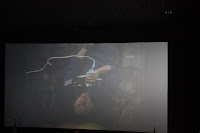Going at a rate of 17,500 miles per hour, I think they are over the South Pacific right now…




The still picture on the big screen in Theater 6 (capacity of 500 and where students from Peninsula School District are waiting in the wings to ask their questions of astronauts Mike Fincke and Sandra Magnus) flicks over to live feed video of the ground station responsible for actually doing the hooking up, and we’re off to a running start.
Kareen Borders, by all accounts THE person responsible for making this historic event happen by “bugging NASA until they gave in,” and Key Peninsula Middle School science teacher, addresses attendees in several theaters on each of their respective screens. She praises this partnership between business and education as bringing badly-needed cutting-edge technological achievement to students—opening their eyes to the world of science and hopefully to all that can be achieved through it. Including jobs that might not even exist yet.
When a disembodied voice announces that they are ready, the screens fill with the visages of Mike and Sandra in their royal blue uniforms emblazoned with the American flag and floating, bouncing—Sandra’s brown hair sticking up all around her head. We are mesmerized as we realize, Hey! They are in space! An appreciative murmur could be heard as Mike says they are “ready” the same time Kareen Borders thanks them. Little bit of a time lag between the theater and the space station but surprisingly not a time lag between Mike and Sandra and us as their mouth movements coincide with the audio.
Questions ranged from What is it like to sleep? Mike: We sleep in a sleeping bag that’s tethered down—that’s important, to “What are the effects on a human body staying in space so long?, Sandra: Calcium leaks out of our bones…similar to osteoporosis…we counter the effects through ingestion of calcium and exercise, to a thought-provoking question, How do you get resistance to use for exercising [due to lack of gravity]?, Sandra: Pulling against a vacuum [one of a few machines that helps].
There were at least a dozen kids who asked questions—sometimes relaying questions from kids from out of state and a few technologically science-savvy questions that had us adults scratching our heads.
The light bouncing and floating (and Sandra’s hair) were a little disconcerting to watch at first, but with Mike doing somersaults and sipping juice (letting fly a couple of big droplets that he then gobbled up mid-air), he entertained the crowd while Sandra answered questions.
At one point Sandra pointed out that they were basically human guinea pigs (which they were happy to be, don’t-get-her-wrong) to gauge how humans fare long-term in outer space and collecting all the data that would help for future long-term endeavors to the moon or even, Mars. As Mike put it, How much do we really need to survive or better yet, how little?
They have already learned how to make oxygen, recycle their urine, and harness solar energy for all their energy needs.
The astronauts were clearly enjoying themselves and the audience even more so as we caught a glimpse of life in outer space via Sandra’s and Mike’s answers.
As the downlink winded down and the astronauts waved their final goodbyes, there was a feeling that something magically momentous just happened.
Galaxy CEO Frank Rimkus then reiterated that even though there have been downlinks happening since 2001, with only a few in the last two years, this was the first time that it happened between the private sector and public education. He was proud that they were able to offer an educational entity the use of the state-of-the-art equipment that their Galaxy Uptown theater provided and to which most schools don’t have access to. He thanked the local Rotary Clubs for getting together funding to bus the students and acknowledged the presence of representatives from the Gates Foundation, the Paul G. Allen Foundation, the Russell Foundation, and the President of Washington Roundtable. Contingents from McChord AFB, Fort Lewis and Bremerton’s naval community were present as well as representatives for Gov. Gregoire and Sen. Derek Kilmer, whom Rimkus also acknowledged.
But ultimately, it was the presence of the students themselves that brought energy and purpose to such an event, and thanks to the formation of community and business partnerships, they were given an opportunity to embark on the right road in their journey to compete in a global workforce.


Guest Author: Mimi Jansen, Communications Coordinator
Tacooma-Pierce Co. Chamber






